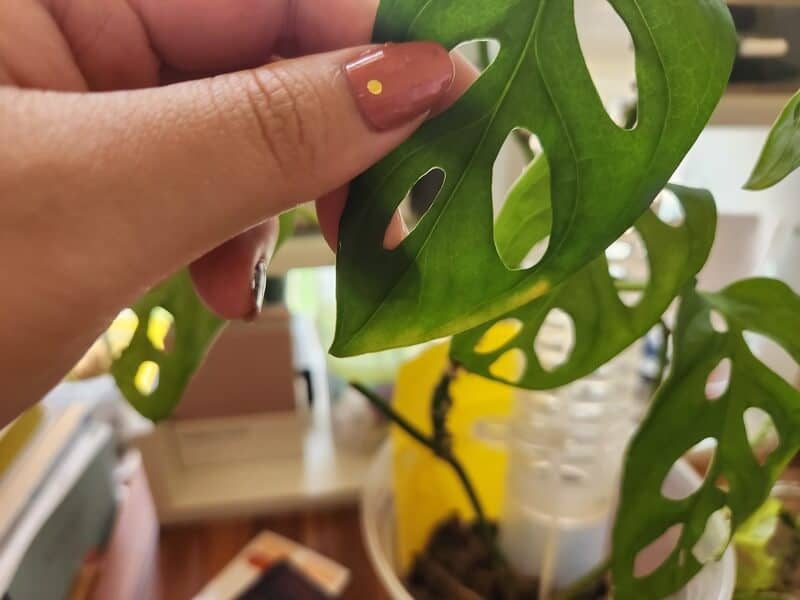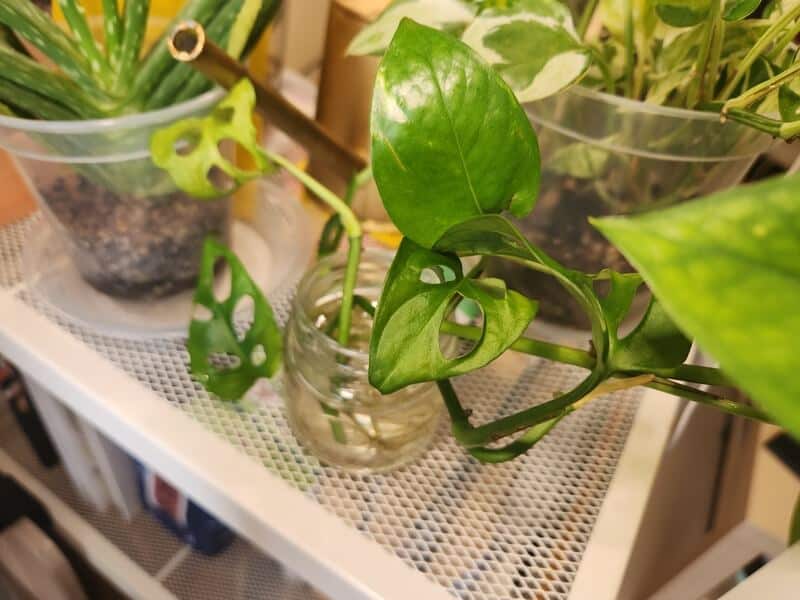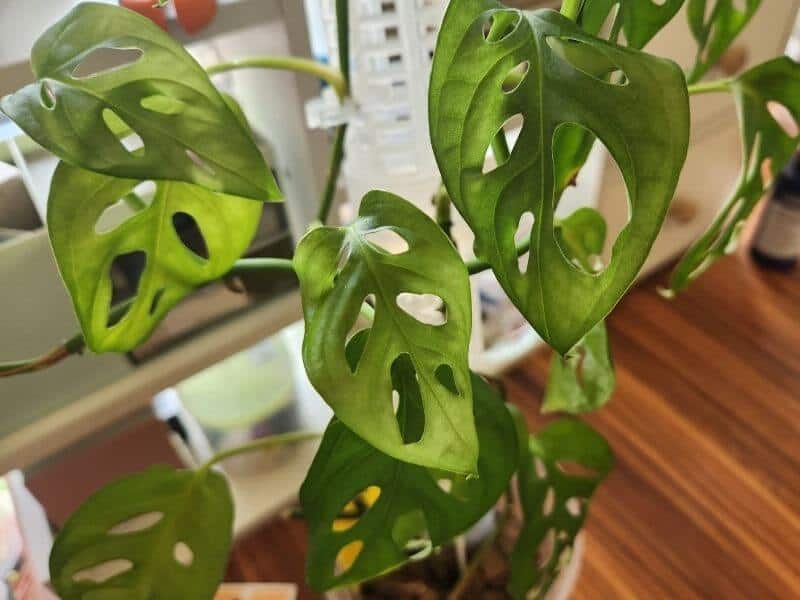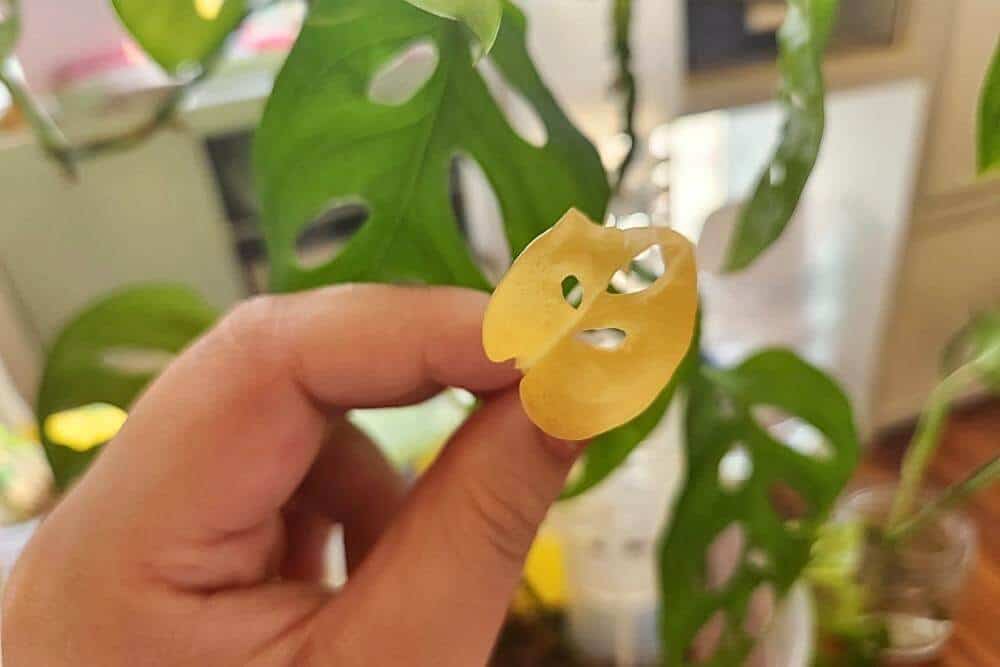Glossy green (or variegated) leaves are a point of pride for Monstera owners. It can feel so good to look at your Swiss Cheese Plant or Silver Monstera and see healthy foliage with prominent fenestrations.
Then you check ’round the side and notice a leaf or two has started turning yellow. Eek!
Monsteras are pretty resilient, but certain conditions can lead to yellowing leaves, including:
- Natural ageing
- Shock
- Overwatering
- Underwatering
- Light exposure
- Temperature changes
- Root-bound plant
- Pests and diseases
- Nutrient deficiency
Leaves are a key indicator of plant health, and discolouration can be a sign of distress. So don’t ignore yellow Monstera leaves — the plant is telling you it needs help!
Why Are My Monstera Leaves Turning Yellow?

A yellowing leaf can look alarming, but don’t panic! If you can identify the cause of yellow leaves on a Monstera, you can treat the plant and get it healthy again.
Natural leaf cycle
Plants don’t live forever, and neither do their leaves!
As your plant grows and ages, the lower, older leaves will naturally turn yellow and fall off. Your plant is simply focusing its energy on new growth.
If you’re seeing new leaves emerging and only the older foliage at the bottom is yellow — without other issues — that’s just part of the plant’s life cycle.
HOW TO FIX IT:
Thankfully, in this case, there’s nothing to fix! Keep caring for your Monstera as usual, and wait for the leaves to drop off by themselves.
Shock
Monsteras, like other plants, can suffer from “shock.” It usually happens after repotting or when moving a plant to a new environment — including when you take home a new plant.
When a plant is uprooted and replanted somewhere else, and then begins yellowing, it’s termed “transplant shock.” It can even happen when transferring Monstera propagations to soil.
Other examples of sudden changes that can shock a plant include:
- Sunlight levels
- Exposure to elements (e.g. wind)
- Moving indoor plants to the outside
- Soil differences (e.g. pH level or moisture)
Other signs of shock include leaf curling, stunted growth, and sudden loss of foliage.
HOW TO FIX IT:
Usually, there’s no need to do anything — in fact, introducing more changes can often make things worse.
It’s normal for the plant to lose a few leaves with repotting or transplanting, but it should bounce back with proper care.
However, if your Monstera sees a lot of yellow, wilting leaves and stems, it’s worth checking the roots. Carefully remove the plant from its pot and inspect the roots through the soil.
Look for signs of damage, mushiness, or withering.
Snip off damaged roots with a pair of disinfected shears and gently replant the Monstera, then water thoroughly. Be careful not to overwater, though!
Overwatering
Speaking of overwatering, this is one of the most common causes of Monstera leaves turning yellow.
Overwatering actually refers to watering too often, not using too much water! If your Monstera’s soil doesn’t get to dry out, it can drown the roots and lead to root rot.
An overwatered Monstera looks like it’s “sick” — besides the yellowing leaves, you’ll have wilting foliage and stems. When you check the roots, you’ll find they’re dark, mushy, and smelly.
If your pot doesn’t have proper drainage, the soggy soil can also lead to rot.
HOW TO FIX IT:
Stop watering immediately and inspect the roots. If you see root rot, you’ll need to cut off all the affected roots with disinfected shears and repot the Monstera in fresh soil.
Make sure the pot has enough drainage holes as well.
Wait a few days before watering the plant, and allow the potting soil to dry out in between watering. Do not let the plant sit in a wet saucer or decorative pot.
Underwatering
On the other hand, too little water can also lead to a Monstera turning yellow.
In the early stages, an underwatered Monstera can look like overwatering — yellow, droopy foliage. A key difference is that an underwatered plant will start showing dry or crisp brown leaves.
When you check the soil, it will feel brittle and dry. In severe cases, the soil has pulled back from the edges of the pot — a sign that it’s become hydrophobic (cannot retain moisture).
HOW TO FIX IT:
Do not suddenly drench your Monstera in water! The soil or roots may not be able to absorb moisture properly, and the roots may rot in wet soil.
Instead, place the pot in a larger container of water (about halfway up the pot). This is called “bottom watering,” and it allows the soil to slowly rehydrate by taking in water through the drainage holes.
Leave the Monstera for a few hours, then lift it and allow any excess water to drain out. Keep an eye on the soil moisture levels afterwards, and water when mostly dry.
If the soil has trouble retaining moisture or dries out very quickly, it’s too hydrophobic and should be changed.
Light exposure

Monsteras need lots of bright, indirect light to maintain healthy foliage. If there’s too little light, the plant can’t photosynthesise properly, causing the foliage to turn yellow and wilt.
On the other hand, too much direct sunlight can scorch the foliage and lead to leaf burn. You’ll see brown spots surrounded by yellow, especially on the delicate edges of leaves.
Variegated types of Monstera are the most vulnerable to scorching.
HOW TO FIX IT:
Reposition your Monstera to give it at least 6 hours of medium to bright, indirect sunlight. A north- or northeast-facing window is best for indoor plants in Australia.
If you don’t have a sunny window, consider getting full-spectrum grow lights! These mimic sunlight, and many have a timer to turn on and off automatically.
For leaf burn, move the plant away from a window, or indoors for an outdoor/balcony plant. Keep your Monstera out of the harsh afternoon sun.
Temperature fluctuations
Monsteras are tropical plants, so they prefer temperatures between 18º–30ºC and humidity levels of 50% or higher.
Exposure to temperatures that are too low or too high, or sudden fluctuations, can stress the plant. The same goes for cold drafts from vents or high temps from a nearby heat source.
HOW TO FIX IT:
Keep your Monstera away from any direct sources of heat or cold, such as a heater or an air-conditioner. Make sure it’s out of any drafts as well.
Be mindful of the temperatures and humidity levels around your plant. Try not to subject your Monstera to fluctuations greater than +/- 10ºC or humidity levels below 45%.
If you’re having some trouble, consider an indoor greenhouse with a glass cabinet!
Root-bound plant
As your Monstera grows, it will continue putting out new roots to fill its existing container. When the plant’s roots have crowded out the soil, it’s root-bound!
A root-bound plant struggles to absorb nutrients or water from the soil, leading to yellowing leaves and stunted growth.
If your Monstera has a clear pot, you can see when the roots have filled the pot — they’ll be circling or crowding each other. Otherwise, look for roots poking out of the drainage holes.
HOW TO FIX IT:
You’ll need to repot your Monstera! The plant’s roots have overgrown the container, and there’s no longer enough soil to provide moisture and nutrients.
Carefully ease the Monstera out of its container, then check the soil and roots. If there are no issues, transfer the plant — soil, roots, and all — to a new container no more than 3–5cm larger.
Fill in any gaps with new potting mix and lightly shimmy the pot to settle the soil. Water well afterwards, and be mindful of transplant shock.
Pests and diseases
Certain pests can take sap and nutrients from your Monstera, leading to leaf yellowing and other issues. Aphids, mealybugs, and spider mites are common sap-sucking pests on indoor plants.
Diseases like leaf spot and mildew can also cause Monstera leaves to start yellowing.
HOW TO FIX IT:
Inspect your Monstera for signs of pests or disease — you’ll usually see something in the leaves and stems. Once you’ve identified the cause, quarantine your Monstera from other indoor plants and treat it accordingly.
You can tackle pests with a neem oil or insecticidal soap spray. For spider mites, dip a small brush in water, rubbing alcohol, and a drop of dish soap, then brush off the webs on the foliage.
Use an appropriate solution, like a fungicide, for plant diseases. Prune off all affected foliage and dispose of it properly (do not compost it).
Nutrient deficiency
It’s less common, but your Monstera leaves may be yellowing due to a nutrient deficiency. It usually happens if you haven’t repotted in a long time or use a hydroponic (grown in water) setup.
Plants need essential nutrients like nitrogen and magnesium, which they get from the soil. For indoor houseplants, you’ll need to replenish those nutrients with a good fertiliser.
HOW TO FIX IT:
Use a balanced liquid fertiliser every 4–6 weeks (or as recommended) during the growing season. Follow the product instructions for dilution.
For hydroponic setups, opt for a water-soluble fertiliser. You’ll usually have to fertilise year-round, as water doesn’t contain enough nutrients by itself.
Keep in mind that too much fertiliser can also cause yellowing in the form of fertiliser burn. Stick to the recommended strength and frequency for the product.
Should I Cut Yellow Leaves Off a Monstera Plant?
If the plant has no pests or diseases, there’s usually no need to cut off the yellowing leaves. The foliage will loosen and fall by itself when the plant is ready.
You can give the leaf a light tug and see if it comes off easily — if yes, then no harm done! But if you feel some resistance, leave the leaf (ha!), as it’s not ready to fall yet.
For Monsteras with pests or diseases, though, you must prune off all affected foliage to prevent spreading. Dispose of the cut parts properly and disinfect your shears afterwards.
Can Monstera Leaves Be Revived After Yellowing?
Unfortunately, once a leaf starts turning yellow, there’s no reversing the process. The leaf has already begun to die as the plant stops sending nutrients.
However, as long as you still have some green stems and healthy roots, the rest of the plant can survive!
Prevent (Most) Leaf Yellowing With Proper Care

You can’t avoid Monstera leaves turning yellow entirely — foliage will wilt with age, and plants aren’t immortal.
However, proper care and growing conditions can prevent many causes of yellowing leaves. Make sure your plant has good air circulation, adequate water, and plenty of natural light (or a grow light).
If you do come across issues, identify and address them accordingly. Avoid trying too many solutions at once, as you could stress the Monstera even further.
Keep in mind that too much leaf loss, disease, or rot may signal that the plant is dying. In that case, it might be better to “chop and prop” and start over from propagation.
However, Monsteras are hardy plants, and they can usually bounce back with some extra TLC. Remember: as long as there’s still green on your plant, there’s something to save and grow!

